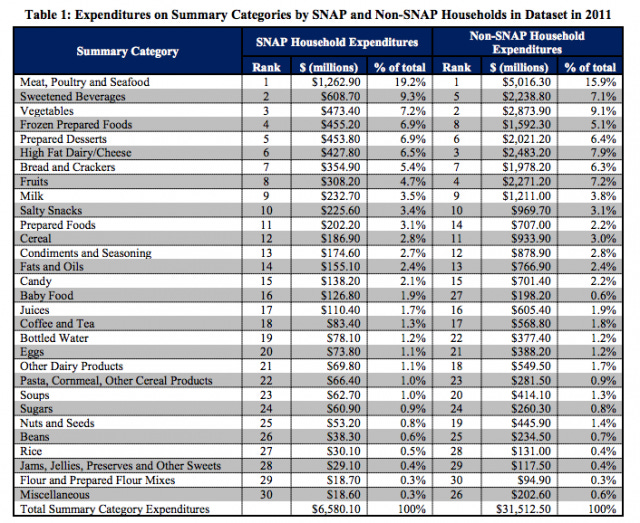Learning to Eat on Food Stamps

By now, you may have read about last week's USDA report on what low-income families buy with their food stamps (officially known as Supplemental Nutrition Assistance Program or SNAP benefits). Or more accurately, you may have read the initial media coverage which wrung hands over the amount of soda poor people are buying. (Not actually grocery carts full, as the photo suggested, but 5 percent of their food dollars!)
Hopefully that means you've now also read responses from various reputable corners (including the NYT's own public editor) pointing out how that was a blatant mischaracterization of the report, which found virtually no difference in the soda spending habits of SNAP and non-SNAP households (who put, um, 4 percent of their food dollars towards soda). In both kinds of households, about 40 cents of every food purchase dollar was spent on kitchen staples like meat, fruits, vegetables, milk, eggs and bread. In both households, another 20 cents was spent on soda, juice, candy, salty snacks and sugar. (The rest was frittered away on rice, beans, and other cooking ingredients.) It's not the sexiest graphic, but I'm including the chart below straight from the USDA's report summary because I think it's really worth parsing. (Click the image to enlarge it in your browser.) If you do, you'll notice the only significant difference in how poor people and rich people buy groceries is that poor people buy a lot more baby food. They do persist in feeding their children.

Nevertheless, the bizarre media response to this report raises a big question: Should the government be restricting how much soda you can buy with your food stamps? Lots of folks in the public health community say yes because soda is full of sugar and chemicals and nothing else. Lots of folks (including me) in the poverty advocacy community say no. For starters, it's the kind of argument Republicans like to make when they're really just looking for ways to cut SNAP funding, period. If you really want poor people to buy more healthy food, the quickest way to do it is actually to give them more SNAP dollars. Giving people an extra $30 spurred them to buy more fruits and vegetables and less fast food according to research by the Center for Budget and Policy Priorities.
A SNAP soda ban also penalizes one group for something that's really not on their shoulders. The over-abundance of soda and sugary foods in our grocery stores is proof we need to reform the food industry, not punish consumers for buying what they are so relentlessly sold. Maybe this kind of thing would make sense once we've succeeded in flooding the marketplace with affordable healthy foods (including options that don't require much cooking, and thus are actually useful to cash- and time-strapped families). Until then, all we'll accomplish is the enforcement of a racist, classist double standard where President Trump (who, by the way, now also lives in government housing and eats food on the taxpayer's dime) is allowed to stock the White House pantry with his beloved Lays potato chips, but poor people aren't entitled to the same small luxuries.
Thinking about all of this brought me back to a conversation I had in 2011, with Amy Bardwell, a nanny and married mom of two on food stamps in the Los Angeles suburbs. "I've had to get over my own preconceptions, where I'd think, 'Oh, you just need to work harder,' or 'Don't waste your money on the nonessential stuff,'" she said. "Because now it's my son's birthday and I really want to buy some frosting to put on the cake mix we got at the food pantry. And that's a nonessential. But it just doesn't feel that way when it's your child."
PS. You can read more about Amy and other Americans living on food stamps, in my Parents Magazine piece. Oh and there's also the time a welfare mom took me grocery shopping, over here in Harper's. I'd have to check my notes, but I'm fairly certain we didn't buy a single bottle of soda.
PPS. Of course, The Onion nailed this.








